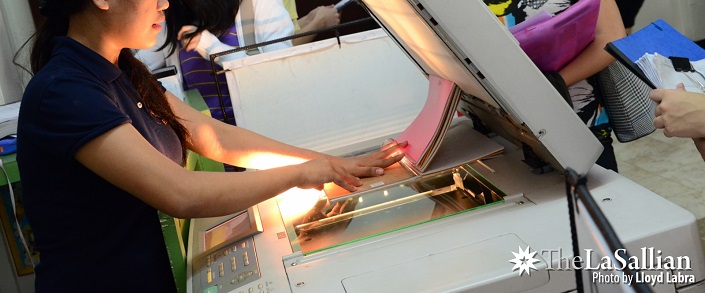
Republic Act (RA) 8293, otherwise known as the Intellectual Property Code of the Philippines, ensures the security of property rights in the country. The law institutionalizes the state’s recognition of the importance of protecting intellectual and industrial property for national development.
The mandate, consequently, is not limited to the national level. Even within the University, the protection of property rights is systematized. By law and by order, students and professors must respect the intellectual property rights of authors.
Constraints such as price and availability of materials, however, have prompted students and professors to resort to alternative means of obtaining copyrighted materials such electronic versions; photocopying entire books and obtaining exact copies that were made to look like original books.
Arguably the most widely used among these is photocopying, a practice that has long been done in Universities here and abroad.
The University also recognizes the challenge of eliminating the use of photocopied books. According to Intellectual Property Office (IPO) Director and Vice Dean of Ramon V. Del Rosario College of Business (RVR-COB) Atty. Christopher Cruz, the University has eliminated all photocopied books in the library.
He adds, “I think that’s one of our successful programs. Our University library has a notice prohibiting photocopying the whole book. If it is just a part, it should not be a substantial [one], otherwise it would still be a violation.”
As a general rule, photocopying is allowed for academic purposes and public information as a fair use principle. It is deemed an infringement when students photocopy a substantial portion of a book.
The question now lies on the definition of “substantial.” Cruz explains, “It’s not in the quantity but it’s in the quality. If it’s the heart of the work, it is not fair use anymore. But, usually it’s the number of pages if you really cannot determine the heart of the work. More than 10 percent is already substantial.”
The University is currently negotiating the acquisition of a license from Filipinas Copyright Licensing Society, Inc. (FILCOLS), a copyright organization that is a licensee of numerous books worldwide. The organization has entered into treaties with different associations in several countries to allow for a larger number of pages to photocopy. New licenses would legally allow academic institutions to photocopy larger portions of books and publications.
Cruz posits that photocopying has become a social or economic issue. Today, photocopying is no longer an active practice due to technological advances. People used to photocopy because it is cheaper and readily available, but the arrival of the Internet and e-books have minimized availability and cost issues. “It’s still happening now, just like piracy and infringement,” Cruz furthers.
Some students see photocopying as a more convenient way to study. Czarina Hizon (IV. ChE) affirms, “I usually photocopy books because I learn effectively when I have the actual material right in front of me.” She also believes that photocopying is an acceptable practice because of practicality and accessibility. She adds, “It is not very [reasonable] to buy a book worth Php 2,000 in which you only need one or two chapters. I might as well photocopy to reduce expenses.”
Meanwhile, some students oppose photocopying as an acceptable practice. Kent So (I, TCPEDUC) admits that he does not encourage others to photocopy reading materials. “The library should suffice. That’s also the reason why we sell books. It’s also the right of writers and publishers to earn from their works,” he explains.
Moreover, Kyle Mendoza (I, JDCTR) sees photocopying as acceptable, but not duly legitimate. She shares that though some authors do not see this as a problem, limitations should be drawn. “Do not reproduce to sell,” she claims.
